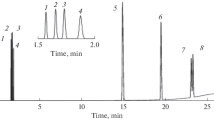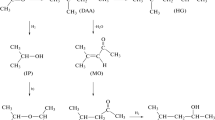Summary
Glass capillary gas chromatography was checked with regard to the authenticity of quantitative results for the analysis of polycyclic aromatic hydrocarbons (PAHs) in airborne particulate matter. A PAH fraction, which was routinely separated from particulate matter by solvent extraction (methanol), liquid-liquid partition (cyclohexane/methanol-water) and two steps of column chromatography (SiO2/cyclohexane and Sephadex LH-20/propanol-2), was further fractionated with the above mentioned Chromatographic system Sephadex LH-20/propanol-2. By analyzing the fractions obtained so far with glass capillary chromatography and g.c.-m.s. coupling, the interfering substances were determined qualitatively and quantitatively concerning 14 selected PAHs. It was shown that some errors in determining PAH values may be avoided, if PAHs with less than four rings are exactly separated from those with four and more rings in the last Chromatographic step; but quantitative data for some PAHs may be biased even in case of a well separated PAH fraction. One of these PAHs is the well known benzo(a)pyrene, which has often been considered as an indicator for the carcinogenic potency of the PAHs in general.
Zusammenfassung
Ein vielfach angewandtes capillargas-chromatographisches Verfahren zur Bestimmung von polycyclischen aromatischen Kohlenwasserstoffen (PAH) in der Atmosphäre wurde auf seine Zuverlässigkeit bei der Gewinnung von quantitativen Analysendaten hin geprüft. Eine PAH-Fraktion, die in unserem Labor routinemäßig durch Extraktion von atmosphärischem Schwebstaub mit Methanol, Flüssig-Flüssig-Verteilung (Cyclohexan/Methanol-Wasser) und zwei säulenchromatographischen Trennungen (SiO2/Cyclohexan und Sephadex LH-20/Propanol-2) gewonnen wird, wurde bei dem letzten chromatographischen Schritt (Sephadex LH-20/Propanol-2) weiter fraktioniert. Durch Untersuchung der so erhaltenen Fraktionen mit Hilfe der Capillar-Gas-Chromatographie und der GC-MS-Kopplung wurden für 14 ausgewählte PAH Überlagerungen durch Störsubstanzen qualitativ und quantitativ ermittelt. Dabei zeigte sich, daß ein Teil der Fehler vermieden werden kann, wenn die PAH mit zwei und drei Ringen exakt von den interessierenden PAH mit vier und mehr Ringen abgetrennt werden. Für einige PAH sind die quantitativen Ergebnisse jedoch auch bei richtiger Schnittpunktwahl mit Vorsicht zu bewerten; zu diesen Verbindungen gehört auch das oftmals als Maß für die cancerogene Potenz einer PAH-Fraktion angesehene Benzo(a)pyren.
Similar content being viewed by others
Literatur
Bjørseth, A.: Anal. Chim. Acta 94, 21 (1977)
Borwitzky, H., Schomburg, G.: J. Chromatogr. 170, 99 (1979)
Dean, G.: 62. Med. J. I, 1506 (1966)
Grimmer, G., Hildebrandt, A., Böhnke, H.: Zbl. Bakt. Hyg., I. Abt. Orig. B 158, 35 (1973)
Habs, M., Schmähl, D.: Berichte 1/79 Umweltbundesamt, S. 191. Berlin: E. Schmidt 1979
Hoffmann, D., Wynder, E.: Chemical Carcinogenesis, S. 342. ACS Monograph 173, Washington 1976
König, J., Funcke, W., Balfanz, E., Grosch, B., Pott, F.: Atmos. Environ. 14, 609 (1980)
König, J., Funcke, W., Balfanz, E., Grosch, B., Pott, F., Romanowski, T.: Staub (im Druck)
Lee, M. L., Novotny, M.: Anal. Chem. 48, 1566 (1976)
Oelert, H. H.: Fresenius Z. Anal. Chem. 224, 91 (1969)
Peters, J., Seifert, B.: Atmos. Environ. 14, 117 (1980)
Pott, F.: Berichte 1/79 Umweltbundesamt, S. 199. Berlin: E. Schmidt 1979
Sawicki, E.: Talanta 16, 1231 (1969)
Stenberg, U., Alsberg, T., Blomberg, L., Wännman, T.: Polynuclear Aromatic Hydrocarbons, S. 313. Ann Arbor Science (1979)
Wilk, M., Rochlitz, J., Bende, H.: J. Chromatogr. 24, 414 (1966)
Wright, B. W., Lee, M. L.: J. High Res. Chromatogr. 3, 352 (1980)
Author information
Authors and Affiliations
Rights and permissions
About this article
Cite this article
Balfanz, E., König, J., Funcke, W. et al. Fehlermöglichkeiten bei der quantitativen Analyse polycyclischer aromatischer Kohlenwasserstoffe aus Luftstaubextrakten mit der Capillar-Gas-Chromatographie. Z. Anal. Chem. 306, 340–346 (1981). https://doi.org/10.1007/BF00468644
Received:
Issue Date:
DOI: https://doi.org/10.1007/BF00468644




